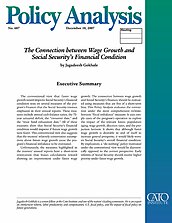Unfortunately, the measures highlighted in the trustees’ annual reports have a short-term orientation that biases calculations toward showing an improvement under faster wage growth. The connection between wage growth and Social Security’s finances should be evaluated using measures that are free of a short-term bias. This Policy Analysis evaluates the connection under the more comprehensive infinitehorizon “fiscal imbalance” measure. It uses simple cases of the program’s operation to explore the impact of the relevant forces—population aging, wage growth, discount rates, and the projection horizon. It shows that although faster wage growth is desirable in and of itself to increase general prosperity, it would likely worsen Social Security’s overall financial condition. By implication, a “do nothing” policy motivated under the conventional view would be diametrically opposed to the correct perspective: Early reforms of Social Security should receive higher priority under faster wage growth.
The Connection between Wage Growth and Social Security’s Financial Condition
The conventional view that faster wage growth would improve Social Security’s financial condition rests on several measures of the program’s finances that the Social Security trustees emphasize in their annual reports. These measures include annual cash-balance ratios, the 75- year actuarial deficit, the “crossover date,” and the “trust fund–exhaustion date.” All of these measures show that Social Security’s financial condition would improve if future wage growth were faster. This conventional view also suggests that the trustees’ relatively conservative assumptions about future wage growth cause the program’s financial imbalance to be overstated.

This work is licensed under a Creative Commons Attribution-NonCommercial-ShareAlike 4.0 International License.

